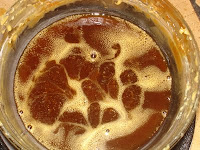The Nossa Senhora da Graça church erected from 1597 to 1602 and now known as St. Augustine’s Tower in Old Goa, has been a subject of great interest owing to the remains of Queen Ketevan, the patron saint of Georgia, from the day news filtered that part of her relics may have been kept in the Chapter Chapel of the Augustine Complex standing on the Holy Hill and overlooking the City of Goa. Ever since this startling report, the Archaeological Survey of India (ASI), Goa Circle has carried out several excavations over a period of 20 years which have revealed startling artefacts and helped in the reconstruction of its history.
 |
| Tools used for the mechanical cleaning of the objects |
The recently concluded excavation at the St. Augustine’s Tower in Old Goa by the ASI yielded among other things a large number of iron objects. In the form of fragments as well as complete specimens, these iron objects included nails, iron hinges, scissors, rings, strips and iron keys. The iron objects unearthed during the excavation had a layer of soil and dust on it. Calcium deposit was also found on some.
Due to its nature, iron rusts when it comes in contact with moisture. The moisture in the soil leads to the deterioration of the iron, making it weak and brittle. In order to preserve these artefacts for future studies, its preservation was therefore of utmost importance.
Preventive Conservation process of the iron objects is being undertaken by the Goa Circle of the ASI with assistance of local manpower that was trained about the project.
Module adopted in the preservation of iron objects
 |
| Frothing of objects immediately after immersion |
The first step is to clean the sediments and other encrustations on the iron object. This is the most tedious process and requires utmost patience on the part of the conservator. The mud and other unwanted materials should be mechanically removed / scrapped off using scalpels and tools which are used in medical surgery (surgical tools). Using a tool of hard bristles, similar to a toothbrush, the first task is to ‘gently clean’ the soil off the artefacts. Care should be taken so as not to damage or flake off the iron object. Patience is the only prerequisite, as it may sometimes take hours to finish just one object!
However, even the most careful of mechanical cleaning cannot ensure the entire object is clean. To remove the dust and other small particles, the iron objects need to be given a wash of kerosene. Carefully rinsing it with kerosene gets the object 80-90 percent rid of its impurities. The objects are then let to dry in a dust-proof environment. Since the quantum of the objects found was large it took the team almost two weeks to finish the mechanical (manual) process and the cleaning with kerosene wash.
 |
| Before and after conservation |
The ultimate goal in cleaning the objects is to make them ready for chemical treatment. This treatment includes coating the object with a thin layer of wax, which acts as a buffer between the object and the environment. The wax is known as ‘Micro-Crystalline Wax’ or MC wax. This wax is melted in a bowl (preferably on a hot-plate) and the iron objects are immersed in it.
The moisture in the pores of the iron object escapes and the wax seeps into the pores. In other words, the wax impregnates the pores of the object. The object starts frothing and bubbles can be seen, the wax providing the much needed strength to the object. The scientific reason behind using MC wax is that it has a high melting point. So even if the mercury is rising outside in the environment, it will not remove the coating. While a normal iron object in a good condition will take about 15 to 20 minutes for the wax to seep in, an object in a bad state of rusting will take at least 30 minutes. This method being reversible, micro crystalline wax can be removed.
When all the moisture has escaped and no more wax can seep in, the bubbles stop emerging. This is the signal to remove the object (with a pair of tongs, of course!). Once removed, the excess wax is wiped on a clean and a smooth cloth. Using a hard brush to polish, the object is then wrapped in cotton wool or similar shock-absorbent material after it cools. This process ensures that the artefact is preserved for posterity.
These iron nails and keys, among others, unearthed from the ruins of Monte Santo will be of considerable help to unlock the doors of a glorious past that saw the ‘rise and fall’ of the Augustinian Complex!
This article has been prepared with the help of valuable inputs provided by:
ABHIJIT AMBEKAR, Assistant Archaeologist, ASI, Goa Circle and
MINESH, Conservator, National Research Laboratory for Conservation (NRLC), Mysore.
(A Version of this article appeared on Gomantak Times, dt: June 27, 2009)
No comments:
Post a Comment